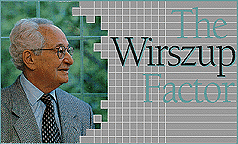
The University of Chicago Magazine
October-December 1996

Continued
Large Numbers on Campus
As the nation's largest university-based mathematics curriculum project, the University of Chicago School Mathematics Project now reaches more than 3 million students--from kindergartners through high-school seniors--in classrooms in all 50 states. Back on campus, the project's numbers are pretty big, as well. Since UCSMP was founded in 1983, with Izaak Wirszup as its principal investigator and U of C mathematics professor Paul Sally as its first director, about 250 people--many of them students from departments around the University--have helped in its development, and at least a half-dozen alumni have coauthored one or more of the series' texts.
Those texts emphasize the importance of numbers--large and small--in a student's life. Using examples drawn from everyday experiences, the elementary curriculum, developed under the guidance of U of C education professor Max Bell, encourages students to begin their study of mathematics in a playful way as they develop an appreciation for math's role in the world around them. Classes keep records of the times of sunrises and sunsets and make charts to show changes during the year. Students measure parts of their body and compare the figures, contrasting the length of the shin bone, for instance, to total body height. The goal is to help students--and their teachers--use numbers with the same ease as words.
With greater ease, the project's directors reason, comes greater speed, and UCSMP ups the pace at which mathematical concepts are introduced. Mirroring the examples that Wirszup observed in his study of Russian texts, the secondary component doesn't concentrate on reviewing arithmetic in junior-high school. Rather, the secondary curriculum--created under the leadership of Sharon Senk, PhD'83, associate professor of mathematics at Michigan State University, and Zalman Usiskin, a U of C professor of education--introduces algebraic concepts in the Transition Mathematics program in seventh grade and offers teachers an opportunity to present algebra in eighth grade. In many UCSMP schools, well over half of eighth-grade students are enrolled in algebra.
One of the more controversial aspects of the UCSMP approach is its reliance on calculators--a calculator is part of the math kit given to kindergartners--although the students are also taught to use paper and pencil and to do calculations mentally. While some traditionalists resist the notion of skipping much of the memorization and drills that long have been part of the mathematics routine, many teachers have been impressed by the results of the program's logic: letting students use calculators frees them from time spent doing repetitive calculations, time which can be used to ratchet up their learning to higher-level mathematics.
"We have seen many of our beliefs accepted by the education community," says Usiskin, UCSMP's director since 1987. "Still," he admits, "there is much work to be done. There are very few specialist teachers in elementary schools, and the mathematical preparation of most elementary school teachers is pitifully weak." To bring teachers up to speed, UCSMP researchers have prepared teacher-development programs and materials, and held conferences to help teachers boost their own math skills.
The numbers look good there, too. MathTools for Teachers, a training package for kindergarten through third-grade teachers, has been adopted by more than 100 school districts nationwide. A recent National Science Foundation grant will help UCSMP develop teacher-enhancement materials for UCSMP and other NSF-sponsored curricula for kindergarten through sixth grade.
Equations of a financial sort also have been adding up for UCSMP. Since 1988, the program's elementary series has been published by Everyday Learning Corporation, an Evanston-based company established in 1988 by the Argonne National Laboratory/University of Chicago Development Corporation (ARCH), which oversees the development of commercial ventures based on University and Argonne research. Last year, when the company had grown to a business with annual sales of between $13 and $14 million, ARCH sold Everyday Learning Corporation to the Tribune Company for the very large number of $25 million.--W.H.
Return to "The Wirszup Factor"
Go to:
- INVESTIGATIONS
- CHICAGO JOURNAL
- EVENTS
- LETTERS
- CHICAGOPHILE
- Feature story, "The Strange Laboratory of Dr. LaBarbera"
- Feature story, "Strength in Numbers"
- Special Report, "Building a Strong Cornerstone"
- Feature story, "The Wirszup Factor"
- CLASS NEWS
- DEATHS
- BOOKS BY ALUMNI
- IN THE CLUBS
Return to October-December 1996 Table of Contents